Focus on Balsam Woolly Adelgid
go.ncsu.edu/readext?297928
en Español / em Português
El inglés es el idioma de control de esta página. En la medida en que haya algún conflicto entre la traducción al inglés y la traducción, el inglés prevalece.
Al hacer clic en el enlace de traducción se activa un servicio de traducción gratuito para convertir la página al español. Al igual que con cualquier traducción por Internet, la conversión no es sensible al contexto y puede que no traduzca el texto en su significado original. NC State Extension no garantiza la exactitud del texto traducido. Por favor, tenga en cuenta que algunas aplicaciones y/o servicios pueden no funcionar como se espera cuando se traducen.
Português
Inglês é o idioma de controle desta página. Na medida que haja algum conflito entre o texto original em Inglês e a tradução, o Inglês prevalece.
Ao clicar no link de tradução, um serviço gratuito de tradução será ativado para converter a página para o Português. Como em qualquer tradução pela internet, a conversão não é sensivel ao contexto e pode não ocorrer a tradução para o significado orginal. O serviço de Extensão da Carolina do Norte (NC State Extension) não garante a exatidão do texto traduzido. Por favor, observe que algumas funções ou serviços podem não funcionar como esperado após a tradução.
English
English is the controlling language of this page. To the extent there is any conflict between the English text and the translation, English controls.
Clicking on the translation link activates a free translation service to convert the page to Spanish. As with any Internet translation, the conversion is not context-sensitive and may not translate the text to its original meaning. NC State Extension does not guarantee the accuracy of the translated text. Please note that some applications and/or services may not function as expected when translated.
Collapse ▲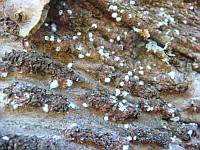 The balsam woolly adelgid is an introduced pest that came into western NC in the early 1950s when the Christmas tree industry was just getting started. It used to be the most difficult to control pest of Fraser fir. This is no longer the case as most growers are getting BWA control with their scale control. However, if you don’t have either RBM or EHS, then BWA may be your worst problem.
The balsam woolly adelgid is an introduced pest that came into western NC in the early 1950s when the Christmas tree industry was just getting started. It used to be the most difficult to control pest of Fraser fir. This is no longer the case as most growers are getting BWA control with their scale control. However, if you don’t have either RBM or EHS, then BWA may be your worst problem.
Cultural Controls
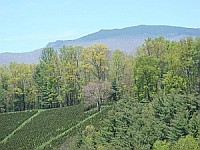
The natural stands of Roan
Mountain provide a source
of BWA crawlers
Fraser fir is probably the true fir that is most sensitive to BWA attack. If BWA is present in your trees, you will almost certainly have to treat it with an insecticide. However, cultural controls can help you reduce BWA impacts and spread.
Avoiding Balsam Woolly Adelgid
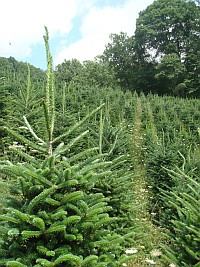 If your Christmas trees are near natural stands of Fraser fir, abandoned or poorly managed Fraser fir stands, or yard trees of Fraser fir or any type of fir, they are more likely to get BWA. Whenever possible, remove large Fraser fir that cannot be treated for BWA from within site of your Christmas trees.
If your Christmas trees are near natural stands of Fraser fir, abandoned or poorly managed Fraser fir stands, or yard trees of Fraser fir or any type of fir, they are more likely to get BWA. Whenever possible, remove large Fraser fir that cannot be treated for BWA from within site of your Christmas trees.
Avoid Excess Nitrogen
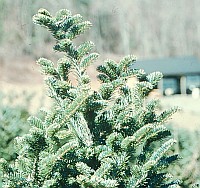 The BWA is another pest that is favored by excessive nitrogen applications. Pests often become more of a problem if the host plant receives excessive nitrogen fertilizer. That nutrition translates into nutrition for the pest, causing it to reproduce better. As many fields have a strong clover component in the ground covers which will supply nitrogen, the use of nitrogen fertilizer throughout the rotation is not needed. Not fertilizing younger trees with nitrogen may reduce problems with BWA in young trees.
The BWA is another pest that is favored by excessive nitrogen applications. Pests often become more of a problem if the host plant receives excessive nitrogen fertilizer. That nutrition translates into nutrition for the pest, causing it to reproduce better. As many fields have a strong clover component in the ground covers which will supply nitrogen, the use of nitrogen fertilizer throughout the rotation is not needed. Not fertilizing younger trees with nitrogen may reduce problems with BWA in young trees.
Early Harvest or Culling
Heavily infested, badly damaged trees often will not recover even after treatment. Pesticide applications never result in 100% control, and these trees will only serve as a source of BWA to reinfest other trees. Trees that will never make a saleable Christmas tree should be cut down and burned. Remove trees that have not had a good top for two years. Do this when crawlers are not present unless you plan on treating the entire field soon afterwards. Otherwise you may spread crawlers to healthy trees when the infested ones are carried out of the field.
Some growers have managed to keep from treating a field for BWA by cutting out and removing infested trees. This can be a viable means of control depending on the cost of treatment and the number of infested trees.
When Chemical Control is Necessary
BWA can kill Fraser fir trees. BWA infested trees do not hold their needles well after harvest. The branches are also brittle, making it hard to bale trees. There are natural predators that feed on BWA such as Harmonia lady beetles, but these predators do not clean up the entire infestation. For these reasons, the presence of BWA always requires an insecticide treatment unless all trees will be harvested from a block of trees the year BWA is found. This is true even in organically grown Christmas trees.
Chemical Control of BWA
Traditional Control: High Pressure Sprayer
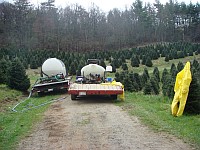 The best control of BWA is with a high pressure sprayer. Treat all surfaces of the tree including the trunk, branches, and foliage. The base of the trunk and under the trunk/branch unions are the hardest places to thoroughly wet, so be thorough. Treat trees from opposite directions. Do not try to treat more than 2 or 3 rows at a time. Butt-pruning trees and mowing tall weeds before treatment will improve spray efficiency. Also treat stumps of trees with live branches still attached. Adelgids will survive on cut stumps for several months.
The best control of BWA is with a high pressure sprayer. Treat all surfaces of the tree including the trunk, branches, and foliage. The base of the trunk and under the trunk/branch unions are the hardest places to thoroughly wet, so be thorough. Treat trees from opposite directions. Do not try to treat more than 2 or 3 rows at a time. Butt-pruning trees and mowing tall weeds before treatment will improve spray efficiency. Also treat stumps of trees with live branches still attached. Adelgids will survive on cut stumps for several months.
Air-blast Mistblower Applications
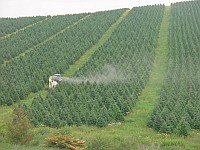 Growers have been able to successfully treat for BWA with an air-blast mistblower. These types of application still require thorough coverage, so do not try to treat many rows at a time. Treat trees from opposite directions. Controls will be reduced in fields with tall weeds and/or heavy density trees.
Growers have been able to successfully treat for BWA with an air-blast mistblower. These types of application still require thorough coverage, so do not try to treat many rows at a time. Treat trees from opposite directions. Controls will be reduced in fields with tall weeds and/or heavy density trees.
Backpack Mistblower
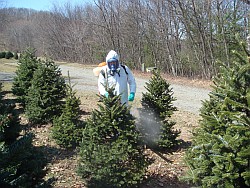
March
For growers with limited acreage, treatments can be made with a backpack mistblower. Target all trees surfaces as with high pressure sprayer application. Treat trees from opposite directions.
BWA Chemicals That Work Any Time of Year
The following materials will control BWA any time of year. That is because it takes about a month for all eggs to hatch to produce the crawler. The chemicals below should stay in the foliage long enough to have an effect upon any hatched crawler. However, the fall window is preferred as there is less impact on natural predators.
| Pests Controlled | Treatment Description |
|---|---|
| BWA BTA Cinara aphids |
ASANA or ASTRO: Will control BWA any time of year. Twig aphids will be controlled when these materials are applied from February through bud break. Fall applications of Asana or Astro will reduce twig aphid populations the following spring. Be sure to scout in the spring to determine the level of BTA control. Adding Dimethoate to Asana in the spring will also control EHS when applied right before budbreak through early September. |
| BWA BTA SSM Cinara aphids |
SNIPER, TALSTAR (or other bifenthrin product): Twig aphids will be controlled when applied any time of year though be sure to scout the following spring to make sure controls are sufficient. Target treatments in fall or winter so as not to increase problems with mites. |
| BWA EHS |
SAFARI: Control of EHS with Safari is best from May through early September. Additional products must be added to control aphids or mites. |
| BWA BTA Cinara aphids |
SIVANTO: Will control BWA any time of year. Twig aphids will be controlled when product applied before bud break. Use will not impact natural controls of elongate hemlock scale including the parasitic wasp. |
BWA Materials that Work when Eggs Are Not Present
| Pests Controlled | Treatment Description |
|---|---|
| BWA BTA eggs (current year) HRM SSM eggs EHS (some control) |
HORTICULTURAL OIL: A 2% horticultural oil solution will control BWA nymphs. Applying oil in mid-March will also control BTA for that spring, HRM, and give some control of SSM and EHS. |


